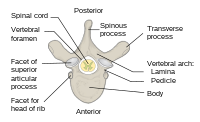Neural arches
| Vertebra | |
|---|---|

A typical vertebra, superior view
|
|

A section of the human vertebral column, showing multiple vertebrae in a left posterolateral view.
|
|
| Details | |
| Identifiers | |
| Latin | Vertebratus |
| TA | A02.2.01.001 |
| FMA | 9914 |
|
Anatomical terminology
[]
|
|
In the vertebrate spinal column, each vertebra is an irregular bone with a complex structure composed of bone and some hyaline cartilage, the proportions of which vary according to the segment of the backbone and the species of vertebrate.
The basic configuration of a vertebra varies; the large part is the body, and the central part is the centrum. The upper and lower surfaces of the vertebra body give attachment to the intervertebral discs. The posterior part of a vertebra forms a vertebral arch, in eleven parts, consisting of two pedicles, two laminae, and seven processes. The laminae give attachment to the ligamenta flava (ligaments of the spine). There are vertebral notches formed from the shape of the pedicles, which form the intervertebral foramina when the vertebrae articulate. These foramina are the entry and exit conducts for the spinal nerves. The body of the vertebra and the vertebral arch form the vertebral foramen, the larger, central opening that accommodates the spinal canal, which encloses and protects the spinal cord.
Vertebrae articulate with each other to give strength and flexibility to the spinal column, and the shape at their back and front aspects determines the range of movement. Structurally, vertebrae are essentially alike across the vertebrate species, with the greatest difference seen between an aquatic animal and other vertebrate animals. As such, vertebrates take their name from the vertebrae that compose the vertebral column.
Each vertebra is an irregular bone. The size of the vertebrae varies according to placement in the vertebral column, spinal loading, posture and pathology. Along the length of the spine the vertebrae change to accommodate different needs related to stress and mobility.
...
Wikipedia
